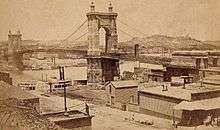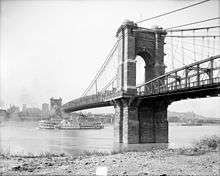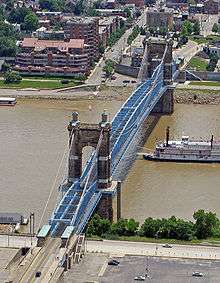John A. Roebling Suspension Bridge
|
Covington and Cincinnati Suspension Bridge | |
 A view of the John A. Roebling Suspension Bridge from Covington, Kentucky on the south bank of the Ohio River with Cincinnati in the background | |
  | |
| Location | Cincinnati, Ohio to Covington, Kentucky |
|---|---|
| Coordinates | 39°5′32.03″N 84°30′34.45″W / 39.0922306°N 84.5095694°WCoordinates: 39°5′32.03″N 84°30′34.45″W / 39.0922306°N 84.5095694°W |
| Built | 1856—1867[1] |
| Architect | John A. Roebling |
| NRHP Reference # | 75000786[2] |
| Added to NRHP | May 15, 1975 |
The John A. Roebling Suspension Bridge spans the Ohio River between Cincinnati, Ohio and Covington, Kentucky. When the first pedestrians crossed on December 1, 1866, it was the longest suspension bridge in the world at 1,057 feet (322 m) main span.[3] Pedestrians use the bridge to get between the sports venues in Cincinnati (Paul Brown Stadium, Great American Ball Park, and U.S. Bank Arena) and the hotels, bars, restaurants, and parking lots in Northern Kentucky. The bar and restaurant district at the foot of the bridge on the Kentucky side is known as Roebling Point.
Ramps were constructed leading directly from the bridge to the Dixie Terminal building used for streetcars. These provided Covington–Cincinnati streetcars "with a grade-separated route to the center of downtown, and the terminal building was originally intended to connect, via underground pedestrian passages, with the never-built Fountain Square Station of the infamous Cincinnati Subway."[4] When streetcar service ceased in the 1950s the terminal was converted to a diesel bus terminal. The ramps were removed in 1998 when it ceased being used as a bus terminal.[5]
Planning and charter

In the decades before 1856, want and need of a passage over the Ohio River was apparent. Commerce between Ohio and Kentucky could not continue unless some form of transportation was devised that did not bow to the whims of mother nature. The distance from shore to shore was great and the steamboat traffic highly congested. The only solution that would not constrict traffic on the river even further was a wire cable suspension bridge of the type developed by French engineers. Several American engineers had begun designing and building suspension bridges. One of these men was John A. Roebling of Saxonburg, Pennsylvania. The Ohio River, however, was much wider than any river that had been bridged in France.
The Covington and Cincinnati Bridge Company was incorporated in February 1846, and the company asked Roebling about a bridge plan. The brief outline of his ideas called for a 1,200-foot (370 m) span with 100 feet (30 m) of clearance at high water to allow steamboats to pass unobstructed, but it included a monumental tower in the middle of the river. Steamboat and ferry interest groups lobbied against this plan, not believing the dimensions stated. They feared an obstructed waterway, loss of a ferry market, depreciation of property, etc. This very closely resembled the opposition to the Brooklyn Bridge that would be voiced in New York City 30 years later. The Ohio legislature refused the charter of the bridge. In September, Roebling published a 36-page report containing a convincing technical discussion and a brilliant analysis of said problems. He attacked steamboat operators for using oversized chimneys, speculated on future commercial interests, and surmised on the importance of spanning western rivers. Roebling also specified that the company should be left autonomous in regard to decision making concerning the placement of the bridge along the river. Still, no charter was granted.

After observing the construction of a suspension bridge upriver, in Wheeling, Virginia (later West Virginia), the legislature relented and passed the charter, mandating excessive dimensions such as a 1,400 feet (430 m) main span, and refusing the specified autonomy. This latter provision would later be regretted by everyone involved. The roads of Cincinnati and Covington were laid collinear with each other, in the hope that a bridge would be built sometime in the future. When the Ohio legislature decided to choose its own location for the bridge, it failed to pick such an obvious spot, hoping to defend Cincinnati's preeminence over Newport and Covington, the rival Kentucky cities. The bridge itself would be located almost entirely in Kentucky because the state boundary follows the north bank of the river. It deprived Cincinnati forever of one of "the finest and most magnificent avenues on this continent."
In 1854, a small suspension bridge over the Licking River at Newport collapsed. This event deterred investors, and the bridge company could not raise enough money to start construction. Amos Shinkle was elected to the board of trustees in 1856. He brought with him a much needed boost of energy. Shinkle immediately managed to find new private investors and to procure more support from both the Ohio and Kentucky governments. During this time the bridge charter was revised, and the span of the bridge was reduced to a minimum of 1,000 feet (300 m). By now, Roebling had built himself a reputation. President Ramson of the bridge company traveled to see Roebling, who was in Iowa, and he secured a contract to build the bridge. In September, Roebling arrived in Cincinnati, and, much to his disgust, nothing was prepared. The recent events had caught the bridge company unaware.

Construction
The digging of the foundation of the Covington tower commenced in September 1856 and went smoothly. A foundation was set consisting of 13 layers of oak beams, each layer set perpendicular to the one beneath it, bolted with iron hardware, and finally all cemented into place. On the Cincinnati side, work was delayed from the start. The construction crews could not pump water out of the excavating pit fast enough. They were attempting to dig to bedrock in the middle of a flowing river. After months of a virtual stand-still, Roebling decided against buying costly machinery or bigger engines for his pumps and, quite last minute, designed his own square positive displacement pumps from three-inch (76 mm) pine planks. He built them locally in about forty-eight hours and ran them off of one of Amos Shinkles' tugboats, the Champion No.1. The homemade pumps displaced forty gallons of mud and clay in each cycle.
When the crews reached the compacted gravel bed of the Ohio River, Roebling decided this would be sufficient for the foundation of the Cincinnati tower. Oak timbers were laid, mirroring the foundation of the Covington tower, and within three months, masonry on both towers reached above the waterline (which, at this time, was at a record low for the fall). Work halted for the freezing temperatures and increased water level, a practice which continued seasonally until completion of the bridge. At this time, a revised contract was drawn up, stating work was to be completed by December 1858, barring "unavoidable calamities".
After a hard winter of 1856–57, and a wet spring, construction resumed in July 1857. Sandstone was used for the first twenty five vertical feet of each tower base. Limestone encased this sandstone, acting as an armor covering against the constant flow of water and the accidental collision with watercraft. The remaining height of each tower was to be constructed of sandstone, rough cut and with a large draft. Roebling said this gave the towers "a massive look, quite suitable to their function."
Working from July to August 1857, the company was without liquid funds, a problem compounded by the Panic of 1857. Work halted due to the inability to pay for the project.[6] In July 1858, operations resumed again, albeit with a smaller workforce. Only one tower was to be worked on at this time. President Ramson of the company would soon die, and no work would be done during the years 1859–60.
In November 1860, Abraham Lincoln was elected president of the United States, and Civil War would be declared in January 1861. Upon a threatened siege of Cincinnati from Confederate forces, a pontoon bridge would be built to span the Ohio River, allowing Union troops to cross and construct defenses. Soon after (it had become obvious that a permanent structure was vital), money from investors came pouring in. Bonds were sold, and in January 1863 materials began arriving. In the interest of building more quickly, the requirement for the height of the main span was lowered to 100 feet (30 m). Preparations to resume construction were made. Machinery was ordered, new derricks were built—but a renewed threat of invasion again temporarily halted progress. Finally, in the spring of 1863, work commenced and continued until the end of the year.

In the spring of 1864, work resumed again. Although Roebling operated his own wire mill at Trenton, New Jersey, the bridge company purchased one million pounds of wire from Richard Johnson at Manchester, England for the cables that would span the width of the river. Roebling had used Johnson's wire for one of his other bridges. He preferred it over wire made in the United States because it was of better quality and greater tensile strength. Anchorages on both shores were constructed of limestone base and a freestone finish. Eleven ton iron anchors were embedded in each block, securing cables with wrought iron chain links of Roebling's patent. These links resembled almost exactly the ones his son, Washington Roebling, would use in the construction of the Brooklyn Bridge. The Civil War depleted the work force on the project, hindering speed and efficiency until its end.
Work on the bridge proceeded steadily after the end of the war. In September 1865 the first two wire ropes were laid. They were unwound from a spool on a barge, allowed to sink to the bottom of the river, then raised in unison from the riverbed. Wooden crossbeams were laid at regular intervals from the wire ropes and a simple footbridge was constructed for the benefit of the workers. With the Ohio River "spanned," there was a final push to complete the project even through floods and freezing temperatures. The cabling of the bridge went at a feverish pace, having about eighty wires taken across the river per day. Hundreds watched the spider-like process from both shores. And on June 23, 1866, the last wire was taken across, for a total of 10,360 wires. These were subsequently compressed together and wrapped with an outer covering of wire into two cables of 5,180 wires each. Suspenders were hung from the cables by the end of August and 600,000 feet (180,000 m) of oak lumber was laid as the floor across 300 wrought iron suspended beams. Two tracks for streetcars were laid. Diagonal stays were added to increase load capacity, strengthen the floor, and check vibration. Wrought iron trusses were added, running the length of the bridge.
On December 1, 1866, pedestrians walked upon the bridge, known locally only as "The Suspension Bridge," for the first time. Over 166,000 people walked across in the first two days. Final touches were put on the bridge over the next few months, and construction would officially end in July 1867. Only two men died during construction. When the Roebling Bridge was formally opened on January 1, 1867, the driver of a horse and buggy was charged a toll of 15 cents to cross; the toll for three horses and a carriage was 25 cents. Pedestrians were charged one-cent.[7]
Alterations and designations

The original deck of the bridge was built at the lowest possible cost due to Civil War inflation, but the stone towers were designed to carry a much heavier load than was originally demanded. In 1896, the bridge received a second set of main cables, a wider steel deck, and a longer northern approach. The reconstruction significantly altered the appearance of the bridge, but the new 30-ton weight limit extended its usefulness through the 20th century and beyond. In 1976, in honor of America's bicentennial, the bridge was painted blue (rather than brown).[8]
The Covington-Cincinnati Bridge Company—a private company—operated the bridge until the Commonwealth of Kentucky purchased it in 1953 for $4.2 million. The state collected tolls until 1963 when the Brent Spence Bridge was opened on Interstate 75, downstream, approximately 0.6 miles (0.97 km) to the west of The Roebling Suspension Bridge.
The bridge was listed on the National Register of Historic Places in 1975 and designated a National Historic Civil Engineering Landmark in 1983. It remains the busiest of Cincinnati's four non-freeway automobile or pedestrian bridges. Initially called the "Covington-Cincinnati Suspension Bridge" or "Ohio River Bridge", it was renamed in honor of its designer and builder on June 27, 1983.[9]
The Commonwealth of Kentucky closed the bridge on November 13, 2006 to make extensive repairs to the structure.[10] It was scheduled to reopen April 22, 2007, but reopened about a month ahead of schedule in late March. However, it closed again for much of 2008 for repainting.[11] On September 11, 2007, the Commonwealth of Kentucky reduced the weight limit to 11 tons to prevent future structural damage following an analysis by the University of Kentucky.[12] The new lower weight limit prevents buses from crossing the bridge.
The Commonwealth of Kentucky once again closed the bridge at 9AM on April 7, 2010, for a complete repainting. The bridge reopened in November 2010.[13] The closing of the bridge only affected vehicular traffic, while one pedestrian lane remained open.[14]
On January 10, 2013, a large piece of sandstone fell from the north tower causing the bridge to be closed for approximately 4 hours during rush hour. This time was used to remove debris and inspect the tower for further damage.[15]
| Wikimedia Commons has media related to Roebling Suspension Bridge. |
See also
- List of largest suspension bridges
- List of crossings of the Ohio River
- List of historic civil engineering landmarks
References
Notes
- ↑ S. J. Clarke (1912). Cincinnati, the Queen City, 1788-1912, Volume 2. The S. J. Clarke Publishing Company. p. 529. Retrieved 2013-05-20.
- ↑ National Park Service (2007-01-23). "National Register Information System". National Register of Historic Places. National Park Service.
- ↑ Kenton County Public Library (August 1, 2003). Images of America: Covington, Kentucky. Arcadia Publishing. p. 9. Retrieved 2013-05-07.
- ↑ "John A. Roebling Cincinnati Suspension Bridge".
- ↑ "DIXIE TERMINAL BUILDING - Cincinnati, Ohio - American Guide Series on". Waymarking.com. Retrieved 2011-08-26.
- ↑ Charles Theodore Greve (1904). Centennial History of Cincinnati and Representative Citizens. 1. Biographical Publishing Company. p. 849. Retrieved 2013-05-22.
- ↑ Daniel Kenny (1875). Illustrated Cincinnati. Stevens. p. 121. Retrieved 2013-05-19.
- ↑ Clubbe, John (1992). Cincinnati Observed: Architecture and History (1 ed.). Ohio State University Press. p. 176.
- ↑ Mike Rutledge (January 12, 2011). "Ohioans resisted Suspension Bridge". The Cincinnati Enquirer. Retrieved October 19, 2012.
Kentucky used the occasion of the Brooklyn Bridge's 1983 centennial to rename the bridge that Roebling always called the Ohio River Bridge. The bridge became the John A. Roebling Suspension Bridge.
- ↑ "Roebling Suspension Bridge To Close For Six Months". WKRC-TV News. September 8, 2006. Retrieved 2006-11-03.
- ↑ Kerry Duke (March 22, 2007). "Roebling is ready to reopen". The Cincinnati Post. p. A1. Retrieved 2007-04-25.
- ↑ "Buses banned on Roebling". The Cincinnati Enquirer. September 11, 2007. Retrieved 2007-09-11.
- ↑ "Roebling bridge closes for paint job". The Cincinnati Enquirer. April 6, 2010. Retrieved 2010-04-07.
- ↑ "Roebling bridge closes for paint job". WCPO-TV News. Archived from the original on April 8, 2010.
- ↑ "UPDATE: Roebling Bridge back open to traffic". WXIX-TV News. April 19, 2013. Retrieved 2015-07-06.
Bibliography
- Steinman, David Bernard. The Builders of the Bridge; The Story of John Roebling and His Son. New York, Harcourt, Brace and Company, 1945. ISBN 978-0-405-04724-4.
- Tolzmann, Don Heinrich. "John A. Roebling and His Suspension Bridge on the Ohio River." Milford, Ohio: Little Miami Pub. Co., 2007. ISBN 978-1-932250-47-3.
External links
| Wikimedia Commons has media related to John A. Roebling Suspension Bridge. |
- "Bridging the century". The Cincinnati Post. E. W. Scripps Company. 1999-03-25. Archived from the original on 2007-02-06.
- Cincinnati-Covington Bridge (1867) at Structurae
- John A. Roebling Suspension Bridge at Bridges & Tunnels
- John A. Roebling Suspension Bridge at RootsWeb
- Roebling Suspension Bridge photographs by Cincinnati Images
- Roebling Suspension Bridge at Cincinnati Transit
- Roebling Suspension Bridge at Historic Bridges of Michigan and Elsewhere
- Discover Northern Kentucky: Roebling Bridge
- Historic American Engineering Record (HAER) No. KY-20, "Covington & Cincinnati Suspension Bridge, Spanning Ohio River, Covington, Kenton County, KY", 4 photos, 2 data pages, 1 photo caption page